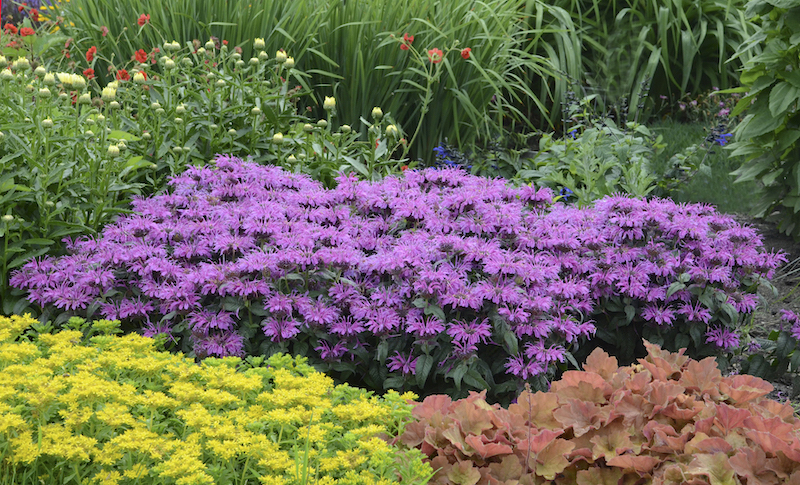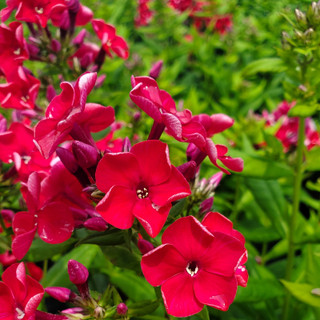Bee balm is an all-around great perennial that can be used to make tea or salad, attract beneficial pollinators, and provide long-lasting color to any garden design. The list of plants that grow well alongside Bee Balm is long and varied. Bee Balm can be used as an accent for Mediterranean and deciduous shrubs, early and late-season perennials, and warm-season annuals with fantastic results. This medicinal herb also entices bees and other pollinators to the kitchen garden, increasing pollination of fruit and vegetables.

Monarda, the Latin name of Bee Balm, demands very little to keep it happy in the garden. Well-draining soil and full sun exposure are essential for vigorous and healthy root formation and reduced risk of mildews or fungal rust diseases, which often plague Bee Balm.
Shrubs To Plant With Bee Balm
Bee Balm pairs nicely with shrubs that prefer drier soils and full sun exposure. Lavender, rosemary, and thyme typically form the backbone of a fully stocked herb garden and look lovely behind lower-growing Bee Balm and its vivid flowers. Although Bee Balm is part of the Mint family, it does not spread as rampantly and can be grown safely between and in front of shrubs. Other more ornamental shrubs such as Abelia, Buddleia, and Spirea share Bee Balm’s preference for full sun exposure and provide long-lasting seasonal color.
Perennials To Plant With Bee Balm
Bee Balm fits into so many different garden plans because it is low maintenance and blends well with both hot colors and cooler pastel shades of flowers. Pink or purple Bee Balm takes on a restful look when paired with either low-growing or tall sedum, highly scented perennial Phlox, and pale creamy-colored Shasta Daisies. Choose hot-colored Coneflowers, Coral Bells, Black-eyed Susan, and Yarrow to carry color through the fall.

Adding Bee Balm to a pollinator garden plan will immediately increase regular visits by beneficial bees and insects. Try planting a few Bee Balm in pots so that they can quickly and easily be moved into areas where early blooming perennials have finished for the season.
Annuals To Plant With Bee Balm
Herb plants in the kitchen garden are great not just for eating, but for encouraging beneficial insects. Bee Balm is known to help protect some edible plants from harmful insects such as squash bugs by attracting birds and other predators that can’t resist a meal of insects. Bee Balm is also unappealing to deer and rabbits, making it useful as a deterrent when grown near other more desirable plants.
Annuals such as basil, squash, cucumbers, and tomatoes all benefit from the pollinators Bee Balm brings to the garden. Other ornamental annuals such as Cosmos, Verbena, and Nasturtium just plain look good alongside the upright and open Bee Balm flowers and have the same growing requirements for an easy, low-maintenance design.
Best Companion Plants For Bee Balm in Containers
Containers full of seasonal annuals and perennials are fabulous for decorating a deck, patio, or balcony and can be changed every year if desired. Bee Balm grows so well in a pot that even the smallest space can be turned into a pollinator-friendly zone. Plant Bee Balm as a thriller amongst fillers like Calibrachoa, Supertunia Petunias, and Trailing Verbena for long-lasting and easy-to-care-for summer color.
Ensure that any container used for growing has sufficient drainage at the bottom and is large enough to accommodate all plants. The above-mentioned combination would fill and grow in a 16-inch diameter pot quite happily. Fertilize container-grown Bee Balm monthly with a diluted liquid feed such as seaweed or fish emulsion.

Plants Not To Grow With Bee Balm
Although Bee Balm grows well with any sun-loving plant, some plants are susceptible to pests or diseases and may transfer them to Bee Balm. Mildew and fungal rust are common to Delphinium, Phlox, and Bee Balm. Avoid planting these plants together or give them plenty of room for air circulation. Bee Balm is more likely to attract mildew when it is grown in a shadier location than it prefers, so avoid planting it with shade lovers like Hostas and ferns.
Although Lettuce is a sun lover like Bee Balm, it attracts so many slugs and snails that Bee Balm will have a hard time growing well. Without using any pesticides or baits, slugs will eat any new growth that emerges early in the spring and can cause significant damage later in the season to flowers and soft stems..
Best Plants To Grow With Bee Balm
The best companions for Bee Balm enjoy the same growing conditions. Select plants that prefer full sun (at least 6 hours), well-draining soil that retains moisture, and moderate levels of nutrients in the soil. For long-lasting color, pair it with Coral Bells, Sedum, Phlox, and Verbena in coordinating hues. This hard-working plant truly deserves a spot in every garden.
 |
Author Robbin Small - Published 9-05-2023 |




